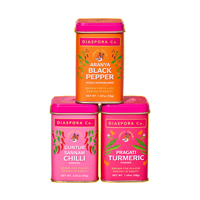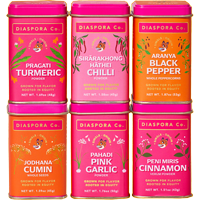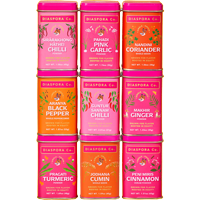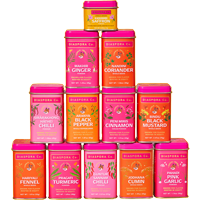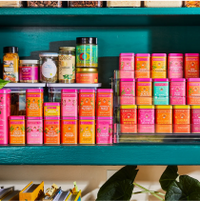
In her article "The Sour, Spicy Fusion Food That's Wildly Popular in India," Annada Rathi writes that Indian-Chinese (also known as Indo-Chinese) cuisine is a "uniquely South Asian phenomenon." The food — which finds its origins in the Hakka-speaking Chinese immigrants who traveled to India at the turn of the 20th century — encompasses a mouthwatering spectrum of flavors: umami, spicy, tangy, a little sweet, and highly aromatic (thanks to lots of ginger, and spices like white pepper). Popular dishes include fiery, saucy chilli panner, crispy Chicken or Gobi Manchurian, and, of course, Hakka noodles. Read more about the history of Indo-Chinese food here.
While the sauce for Hakka noodles can be as simple as a couple glugs of soy sauce, this recipe calls for a few extra ingredients — a splash of unseasoned rice wine vinegar for a sour note, ketchup to keep everything saucy and glossy, Sirārakhong Hāthei Chillies for both smokiness and heat, a few grinds of Aranya White Pepper for a delicate, yet fragrant zing, and a kiss of sugar balances everything out. These noodles are satisfyingly packed with veggies, like shredded green cabbage, carrots, peppers, and onions, but if you want to add a little more heft to the dish, you can incorporate a plant- or meat-based protein. Fry up some tofu prior to cooking the vegetables, or add in chopped chicken thighs, thinly sliced skirt steak, or peeled shrimp. I like things quite saucy, so if I'm adding a source of protein, I double the sauce to make sure every bite is well-seasoned.

Asha's Smoky Hakka Noodles
In her article "The Sour, Spicy Fusion Food That's Wildly Popular in India," Annada Rathi writes that Indian-Chinese (also known as Indo-Chinese) cuisine is a "uniquely South Asian phenomenon." The food — which finds its origins in the Hakka-speaking Chinese immigrants who traveled to India at the turn of the 20th century — encompasses a mouthwatering spectrum of flavors: umami, spicy, tangy, a little sweet, and highly aromatic (thanks to lots of ginger, and spices like white pepper). Popular dishes include fiery, saucy chilli panner, crispy Chicken or Gobi Manchurian, and, of course, Hakka noodles. Read more about the history of Indo-Chinese food here.
While the sauce for Hakka noodles can be as simple as a couple glugs of soy sauce, this recipe calls for a few extra ingredients — a splash of unseasoned rice wine vinegar for a sour note, ketchup to keep everything saucy and glossy, Sirārakhong Hāthei Chillies for both smokiness and heat, a few grinds of Aranya White Pepper for a delicate, yet fragrant zing, and a kiss of sugar balances everything out. These noodles are satisfyingly packed with veggies, like shredded green cabbage, carrots, peppers, and onions, but if you want to add a little more heft to the dish, you can incorporate a plant- or meat-based protein. Fry up some tofu prior to cooking the vegetables, or add in chopped chicken thighs, thinly sliced skirt steak, or peeled shrimp. I like things quite saucy, so if I'm adding a source of protein, I double the sauce to make sure every bite is well-seasoned.
Ingredients
For the noodles
- 12 ounces fresh, wheat noodles (you can also use fresh ramen, chow mein, or udon noodles, too)
- 4 tablespoons neutral oil, such as canola or grapeseed
- ½-inch piece fresh ginger, peeled and finely chopped
- 2 cloves garlic, finely chopped
- ½ white or yellow onion, thinly sliced
- 1 medium carrot, peeled & cut into matchsticks
- 1 medium red bell pepper, thinly sliced
- 1 medium green bell pepper or Anaheim pepper, thinly sliced
- 2 cups green cabbage, shredded
- 2 green onions, thinly sliced
For the sauce
- 3 tablespoons light soy sauce
- 2 tablespoons ketchup
- 1½ teaspoons rice wine vinegar
- ½ to 1 teaspoon Sirārakhong Hāthei Chillies
- ½ teaspoon freshly ground Aranya White Pepper
- ½ teaspoon brown sugar (optional)
Methods
- Bring a large pot of unsalted water to a boil over high heat. Cook the noodles according to the package instructions until just al dente and drain well. Transfer the cooked noodles to a baking sheet, toss with 1 tablespoon canola oil (this will help prevent the noodles from sticking together), making sure every noodle is lightly coated in oil, and set aside.
- To prepare the sauce, mix the sauce ingredients in a small bowl and set aside.
- Heat the remaining 3 tablespoons canola oil in a wok or large skillet, over high heat. Add the ginger and garlic, stirring frequently, and cook until fragrant, about 15 to 30 seconds. Add in the white onion and carrot, and cook, stirring occasionally until the vegetables just start to soften and some pieces begin to caramelized, about 3 to 4 minutes. Add in the red and green bell peppers, as well as the cabbage and continue to stir fry until the vegetables are cooked through, but still retain a little fresh crunch, about 3 to 5 minutes
- Add in the noodles and stir to incorporate the vegetables. Give the sauce a stir and pour over the noodles and vegetables, stirring to coat, and continue to cook until the sauce starts to absorb into the noodles and everything is heated through, about 2 to 3 minutes. Turn off the heat, stir in the green onions and serve immediately.




